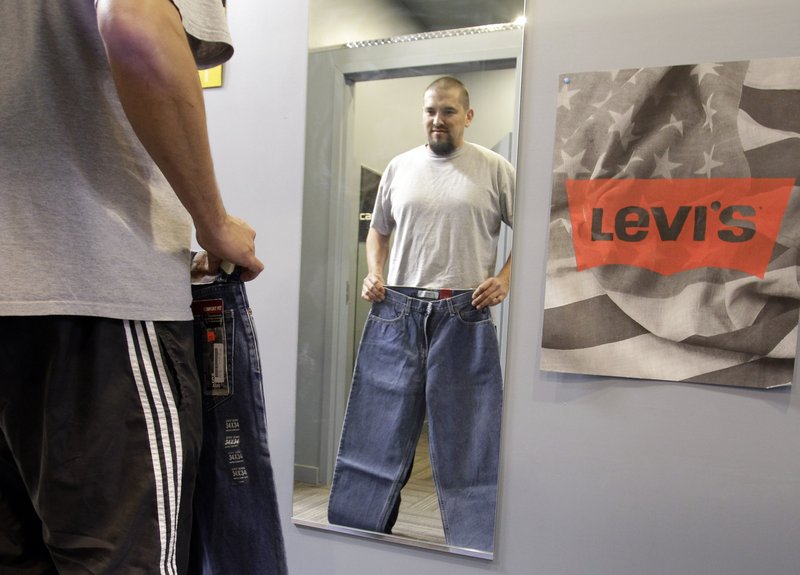NEW YORK — Shoppers looking to update their wardrobes may find their money won’t stretch as far.
As the world economy recovers and demand for goods rises, a surge in raw material and labor costs is squeezing retailers and manufacturers who have run out of ways to pare expenses.
Clothing prices had dropped for a decade as tame inflation and cheap overseas labor helped hold down manufacturers’ costs. During the recession, retailers and clothing makers cut frills and experimented with fabric blends to keep prices in check.
But cotton has more than doubled in price over the past year, hitting all-time highs. The price of synthetic fabrics has jumped roughly 50 percent as demand for alternatives has risen.
Clothing prices are expected to rise about 10 percent in coming months, with the biggest increases in the second half of the year, said Burt Flickinger III, president of Strategic Resource Group.
Brooks Brothers’ wrinkle-free men’s dress shirts now cost $88, up from $79.50. Levi Strauss, Wrangler jeans maker VF Corp., J.C. Penney Co., Nike and designer shoe seller Steve Madden also plan increases.
More specifics on price increases are expected when clothing retailers such as J.C. Penney and Abercrombie & Fitch report financial results this month.
“All of our brands, every single brand, will take some price increases,” said Eric Wiseman, chairman and CEO of VF Corp., which makes clothes for The North Face, Nautica, Wrangler and Lee brands. Cotton accounts for half the production cost of jeans, which make up about one-third of VF’s sales, Wiseman told investors in November.
Higher costs also will affect how clothes are made. Clothing makers are using more synthetics like rayon and designing jeans with fewer embellishments. Shoppers also will have fewer color choices.
Retailers are trying to figure out whether the consumer demand that gave them strong holiday sales will last. The fear is higher prices will nip it in the bud. Stores that cater to low- and middle-income shoppers will have the hardest time passing along price increases.
“We have been so used to deflation for years and years,” said David Bassuk, managing director in the retail practice of AlixPartners. “Customers are going to be surprised.”
Janice Mignanelli of Washington Township, N.J., doesn’t want any surprises.
“I’m not going to spend any more than $50 for a pair of jeans,” said Mignanelli, a stay-at-home mom shopping at the Garden State Plaza in Paramus, N.J., last week. “I’ll just have to cut back on the extras.”
Even affluent shoppers, whose spending has rebounded, may bristle.
“It does give me some pause,” said Jimmy Franco, a 47-year-old publicity executive and fan of Brooks Brothers’ shirts. “Instead of buying two, I may just get one and a pair of socks. There’s a certain amount of money that I’m prepared to spend.”
Cotton has jumped to a 150-year-high, hitting $1.90 per pound on Friday. That’s more than double the price a year ago and just ahead of the $1.89 record during the Civil War, according to the International Cotton Advisory Committee. But the Civil War-era price isn’t adjusted for inflation, and the cotton group says it doesn’t have an adjusted figure available. The government inflation calculator only goes back to 1913, but at that point $1.89 had the same general buying power as $41.63 does today.
Cotton prices began soaring in August 2010 after bad weather cut harvests in major producing countries including China, the United States, Pakistan and Australia.
Restrictions on exports from India, the world’s second-largest cotton exporter behind China, have also produced shortages.
Raw materials account for 25 percent to 50 percent of the cost of producing a garment. Labor ranges from 20 percent to 40 percent, depending on how complicated it is to make, Bassuk said.
On the production side, many Chinese factories that shut down temporarily in the depths of the recession still haven’t returned to capacity. As they ramp up, they’re finding they have to pay workers more because of labor shortages, said John Long, retail strategist at the consulting firm Kurt Salmon.
Until now, retailers have been shifting production to lower-cost countries like Vietnam, turning to new materials and absorbing cost increases.
But they’re reaching the limit, according to Kevin Burke, president and CEO of the American Apparel & Footwear Association.
Mom-and-pop stores are most vulnerable because they don’t have as much power to negotiate better prices with suppliers as stores like Walmart. But even the world’s largest retailer is feeling the pressure.
“There’s no doubt there may be some price increases that come up, but we don’t want to ever let that be the first answer … that just because cotton prices are up, that we’re automatically going to pass that on to consumers,” said Mike Duke, Walmart’s CEO and president, in a recent interview.
Mary Hutchens, owner of Full of Beans, a children’s clothing store in Chevy Chase, Md., worries that price increases could be a death blow. She said she has to discount heavily to stay in business and isn’t sure she’ll be able to pass along the costs.
“Everybody has changed their habits since the recession,” she said. “I’m just trying to hold on.”
Send questions/comments to the editors.



Success. Please wait for the page to reload. If the page does not reload within 5 seconds, please refresh the page.
Enter your email and password to access comments.
Hi, to comment on stories you must . This profile is in addition to your subscription and website login.
Already have a commenting profile? .
Invalid username/password.
Please check your email to confirm and complete your registration.
Only subscribers are eligible to post comments. Please subscribe or login first for digital access. Here’s why.
Use the form below to reset your password. When you've submitted your account email, we will send an email with a reset code.